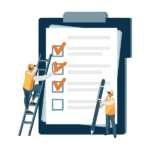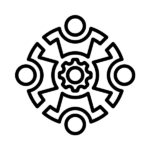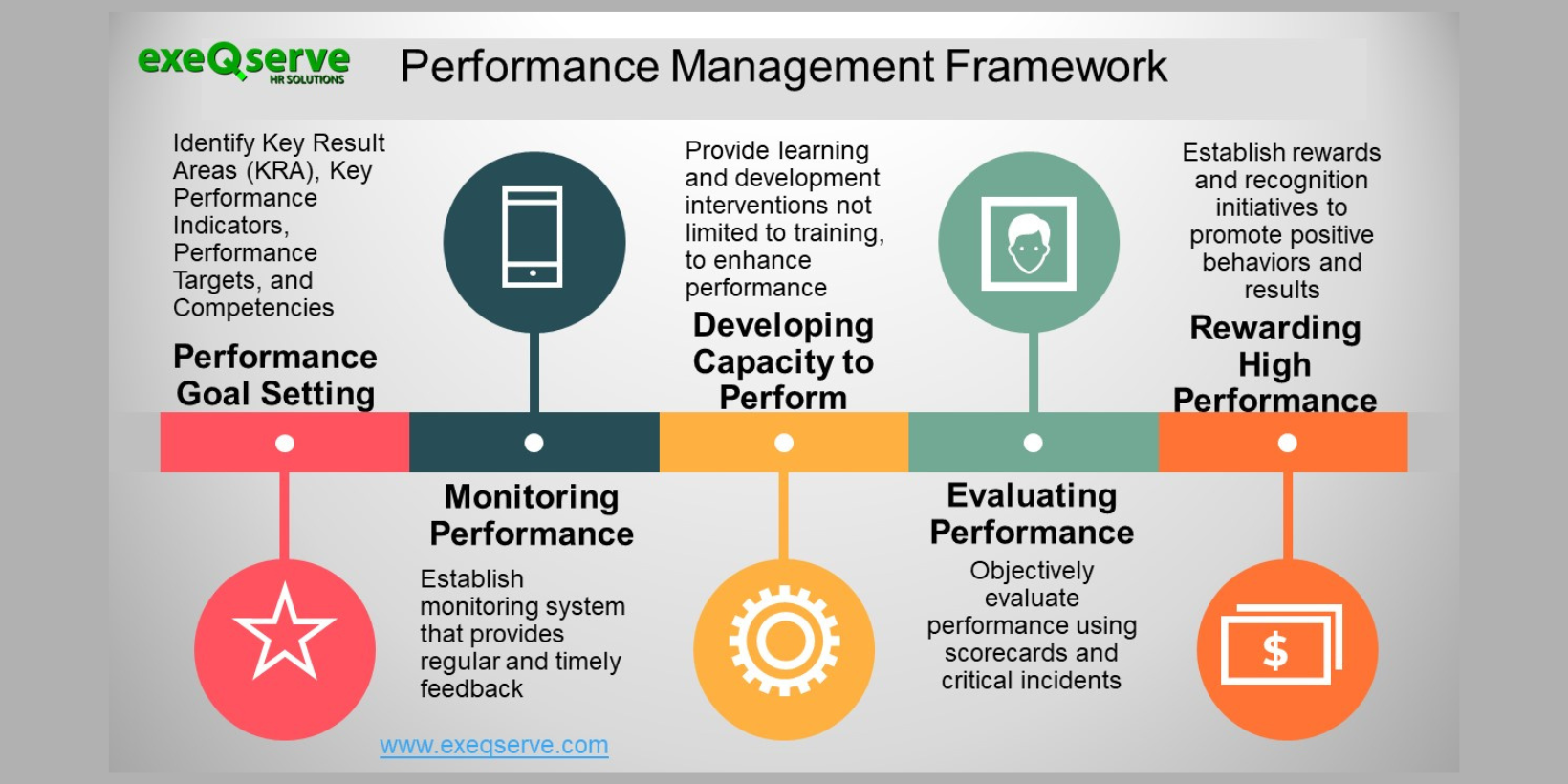Remember that intense conversation in “Usapang Training Atbp” where we delved into performance management as a talent development tool? The confusion between a holistic performance management system and the traditional performance appraisal was unbelievable! The challenge of altering mindsets became evident. This article springs forth from that discussion, aiming to provide HR professionals with a clear roadmap for implementing performance management and talent development strategies that genuinely work.
Unraveling the Components of Holistic Performance Management
Performance management goes beyond a mere annual review; it’s a fluid, ongoing process with interconnected elements that help in talent development toward achieving performance targets. Anchored in a holistic framework, a comprehensive performance management system comprises several critical components:
 Performance Planning: This initial stage involves setting specific, achievable performance targets while also defining the behaviors, competencies, and capabilities required for optimal performance. A well-defined performance plan gets managers and employees to agree on the set of results to achieve and the kind of capabilities or competencies they need to develop to help them achieve their targets.
Performance Planning: This initial stage involves setting specific, achievable performance targets while also defining the behaviors, competencies, and capabilities required for optimal performance. A well-defined performance plan gets managers and employees to agree on the set of results to achieve and the kind of capabilities or competencies they need to develop to help them achieve their targets.
 Regular Monitoring and Feedback: Consistently tracking employee performance ensures alignment with objectives. Regular feedback sessions serve as powerful growth catalysts, offering valuable insights and opportunities for improvement. A sound monitoring system paired with frequent feedback sessions helps build a coaching relationship between managers and employees beyond correcting performance. It also guarantees that achievements are recognized and celebrated.
Regular Monitoring and Feedback: Consistently tracking employee performance ensures alignment with objectives. Regular feedback sessions serve as powerful growth catalysts, offering valuable insights and opportunities for improvement. A sound monitoring system paired with frequent feedback sessions helps build a coaching relationship between managers and employees beyond correcting performance. It also guarantees that achievements are recognized and celebrated.
 Empowering Through Capacity Development: An indispensable facet is investing in employee growth. This encompasses targeted training, one-on-one coaching, and providing resources to enhance skill sets and competencies. This is where performance management and talent development can integrate well. If Managers and HR work together to generate the data needed to address learning and development needs from appraisals and feedback sessions, they can design a set of interventions that truly help the employees.
Empowering Through Capacity Development: An indispensable facet is investing in employee growth. This encompasses targeted training, one-on-one coaching, and providing resources to enhance skill sets and competencies. This is where performance management and talent development can integrate well. If Managers and HR work together to generate the data needed to address learning and development needs from appraisals and feedback sessions, they can design a set of interventions that truly help the employees.
 Appraising Performance: This phase involves a comprehensive evaluation of an employee’s performance, extending beyond numeric ratings. It encompasses qualitative assessments of strengths, areas for growth, and tailored development plans. When the three previously mentioned components are done properly, performance appraisal should be a breeze, and rewards and recognitions will be aligned with the desired outcome of the performance management program.
Appraising Performance: This phase involves a comprehensive evaluation of an employee’s performance, extending beyond numeric ratings. It encompasses qualitative assessments of strengths, areas for growth, and tailored development plans. When the three previously mentioned components are done properly, performance appraisal should be a breeze, and rewards and recognitions will be aligned with the desired outcome of the performance management program.
Check out our Performance Management Workshop!
HR’s Role in Garnering Buy-in and Commitment
Rolling out a holistic performance management system necessitates buy-in from all levels. HR plays a central role in securing top management support, cultivating manager commitment, and fostering employee acceptance and engagement.
Embracing the Essentials of Change Management
Transitioning from traditional performance appraisal methods to a comprehensive system requires a structured approach. John Kotter’s model offers a systematic guide to lead and facilitate this transformative journey.
 Step 1: Cultivate a Sense of Urgency. Illustrate the necessity of change by highlighting the benefits of a holistic performance management system. Address the shortcomings of the existing approach and demonstrate how the new model overcomes them. For HR to successfully do this, they need to recognize the limitations and wastes from poorly designed performance appraisal systems. The outcome of this step is that key stakeholders are willing to invest in the change.
Step 1: Cultivate a Sense of Urgency. Illustrate the necessity of change by highlighting the benefits of a holistic performance management system. Address the shortcomings of the existing approach and demonstrate how the new model overcomes them. For HR to successfully do this, they need to recognize the limitations and wastes from poorly designed performance appraisal systems. The outcome of this step is that key stakeholders are willing to invest in the change.
 Step 2: Build a Powerful Coalition. Assemble a team of influential individuals from diverse departments who are passionate about change. Their support will amplify the transformation’s impact. They need to own the development and implementation of the performance management system. HR’s important role is that of an internal consultant and secretariat. Help form a performance management committee with managers and supervisors as committee members, and have one of the senior managers (VP or C level) as chairman.
Step 2: Build a Powerful Coalition. Assemble a team of influential individuals from diverse departments who are passionate about change. Their support will amplify the transformation’s impact. They need to own the development and implementation of the performance management system. HR’s important role is that of an internal consultant and secretariat. Help form a performance management committee with managers and supervisors as committee members, and have one of the senior managers (VP or C level) as chairman.
 Step 3: Facilitate the development of PMS Vision and Strategy. Formulate an inspiring vision for the future state of performance management. Detail the strategy for achieving this vision and align it with the organization’s overarching goals. All stakeholders need to appreciate that the performance management system will aid their growth, not just help them increase their salaries.
Step 3: Facilitate the development of PMS Vision and Strategy. Formulate an inspiring vision for the future state of performance management. Detail the strategy for achieving this vision and align it with the organization’s overarching goals. All stakeholders need to appreciate that the performance management system will aid their growth, not just help them increase their salaries.
 Step 4: Articulate the Vision. People must not forget the reason for participating in the process and do it well. Regularly communicate the vision and strategy to all stakeholders. Utilize multiple communication channels to ensure the message’s comprehensive dissemination. The goal of the PMS must guide the development of the program policy and capacitate the stakeholders to play their roles well.
Step 4: Articulate the Vision. People must not forget the reason for participating in the process and do it well. Regularly communicate the vision and strategy to all stakeholders. Utilize multiple communication channels to ensure the message’s comprehensive dissemination. The goal of the PMS must guide the development of the program policy and capacitate the stakeholders to play their roles well.
 Step 5: Eliminate obstacles impeding the adoption of the new system. Provide the requisite resources, training, and assistance for managers and employees to seamlessly embrace the change. The communication of the policy and procedures goes here. The training too. It is important that the training covers not just the filling out appraisal forms. Remember, this is the reason why many people only focus on the appraisal. The training should substantially cover all of the components of the performance management system implementation. The training should be done so well, that all participants in the process, can confidently play their roles.
Step 5: Eliminate obstacles impeding the adoption of the new system. Provide the requisite resources, training, and assistance for managers and employees to seamlessly embrace the change. The communication of the policy and procedures goes here. The training too. It is important that the training covers not just the filling out appraisal forms. Remember, this is the reason why many people only focus on the appraisal. The training should substantially cover all of the components of the performance management system implementation. The training should be done so well, that all participants in the process, can confidently play their roles.
 Step 6: Celebrate Short-Term Wins. Showcase early successes to highlight the new performance management’s positive impact. These triumphs generate momentum and instill confidence in the transformation. It helps to pilot the implementation in one willing department and then, celebrate whatever gains are achieved from there. Spread the news and recognize those who contributed to its success. When pilot programs show significant performance improvement, it would be hard to dispute their usefulness.
Step 6: Celebrate Short-Term Wins. Showcase early successes to highlight the new performance management’s positive impact. These triumphs generate momentum and instill confidence in the transformation. It helps to pilot the implementation in one willing department and then, celebrate whatever gains are achieved from there. Spread the news and recognize those who contributed to its success. When pilot programs show significant performance improvement, it would be hard to dispute their usefulness.
 Step 7: Consolidate Gains and Pave the Way for Further Change. Continuously evaluate progress and fine-tune the system as required. Encourage ongoing feedback and incorporate insights for necessary adjustments. Very few things come out as perfect in the first instance. Use Kaizen to continually improve your performance management system.
Step 7: Consolidate Gains and Pave the Way for Further Change. Continuously evaluate progress and fine-tune the system as required. Encourage ongoing feedback and incorporate insights for necessary adjustments. Very few things come out as perfect in the first instance. Use Kaizen to continually improve your performance management system.
 Step 8: Embed Changes in Organizational Culture. Immerse the new performance management practices within the organization’s culture. Ensure their integration into daily operations and long-term strategies. When you hire or promote managers, make performance management training a required course for them. For the individual contributors, make performance management part of their onboarding activities.
Step 8: Embed Changes in Organizational Culture. Immerse the new performance management practices within the organization’s culture. Ensure their integration into daily operations and long-term strategies. When you hire or promote managers, make performance management training a required course for them. For the individual contributors, make performance management part of their onboarding activities.
Check out ExeQserve’s Performance Management System Development and Implementation consulting service.
Personal Preparation: HR’s Journey Towards Proficiency
Before embarking on the change management journey, HR professionals must deepen their understanding of a holistic performance management system:
Mastering the Basics: Acquire an in-depth understanding of performance planning, setting performance goals, and defining key performance indicators (KPIs) and key result areas (KRAs).
Grasping Competencies and Capabilities: Familiarize yourself with the intricacies of competencies and capabilities and their significance in driving employee performance.
Refining Monitoring and Feedback Techniques: Develop expertise in the correct process of monitoring performance and delivering constructive feedback, fostering growth and engagement.
Becoming a Capacity Development Champion: Explore best practices in employee development through training, coaching, and providing resources for skill enhancement.
Nailing Performance Appraisal: Gain insights into effective appraisal methods that encompass qualitative assessments and personalized development plans.
Transitioning towards holistic performance management is a transformative endeavor that goes beyond procedural changes. It’s about cultivating a culture of growth, engagement, and excellence. By embracing the change management model outlined by John Kotter and equipping themselves with a deep understanding of performance management components, HR professionals can lead their organizations through this paradigm shift. Remember, the journey might be demanding, but the rewards—empowered, motivated employees and elevated organizational performance—are undoubtedly worth it.
Develop and implement your company’s own competency-based performance management system using our Performance Management Toolkit Bundle!









